 |
|
| Antillothrix Bernensis • Underwater Windows to the Lost World of Caribbean Monkeys |
Text by Dr. Alfred L. Rosenberger and Siobhán B. Cooke
Photography by Curt Bowen and Walter Pickel |
| Diving caves may be less dangerous than dodging bullets, but it is far outside the air-breathing norms of topside paleontology. Learning from the successes of seaside underwater archaeologists and their own years of experience diving caves, |
|
|
|
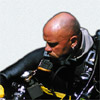 |
|
| Expedition Bacalar |
| Text by Linda Bowen |
Just three hours south of Tulum lies Lake Bacalar, a giant natural fresh water lake which ranges more than 50 miles to the north and south and extends up to a half mile wide. Lake Bacalar is noted for its beautiful turquoise water that is created by its high mineral content.
|
|
|
|
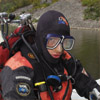 |
|
| Bashkiria Cave Expedition - RUSSIA |
Text by Phil Short
Photography by Gavin Newman |
At one stop we met an old, weather-beaten peasant who lived alone in a wooden hut near the river, producing honey for part of his livelihood—some of which we bought for our journey. Finally, on a pebble beach on one of the large meandering bends in the river, we unloaded all the gear, and pitched camp for the night with a good open fire of driftwood to cook over.
|
|
|
|
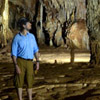 |
|
| Belize - Monster Cave – ADM Exploration Team |
| Text by Walter Pickel |
| Caves are uniquely interwoven into the history and culture of Belize, as they were fundamental to the Mayan people and to their religion. Caves were the portal to the world of the Gods – Xibalba. Every cave we visited showed remains of the Maya. In some caves, the floors of were littered with potsherds |
|
|
|
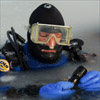 |
|
| Beneath the White Sea: Diving Russia's Arctic |
| Text by Michael Salvarezza & Christopher P. Weaver |
| We had come to this remote spot a week earlier filled with both excitement and anxiety over the prospects of exploring the icy waters of the White Sea. Nestled alongside the Kola Peninsula, and straddling the Arctic Circle, the White Sea, technically part of the Barents Sea, is the only inland sea to completely freeze in the winter. |
|
|
|
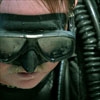 |
|
| Blue Holes of Cay Sal Bank |
Text by Brock Brinkerhoff
Photography by Curt Bowen |
The wall itself was a constant reminder of the tremendous processes that created it. Some areas contained enormous breakdown piles, while others were sheer faces – not unlike those seen in the Grand Canyon.
|
|
|
|
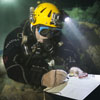 |
|
| Christmas Island's Hidden Secrets |
By Dr. Thomas Iliffe & Dr. William Humphreys
Photography by Ross Anderson, Jill Heinerth & Brian Kakuk |
| Christmas Island, a territory of Australia, lies in the eastern Indian Ocean at 10o 30’ S, or about 350 km southwest of Java and separated from it by the Java Trench. The island, which is the tip of a submerged seamount, rises 4.5 km from the ocean floor. It consists of late Cretaceous to early Tertiary age volcanic rocks that are capped by Tertiary limestones |
|
|
|
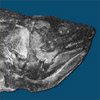 |
|
| Coelacanth Fever - in Search of the Living Fossil |
By Jitka Hyniova
|
| Underwater studies off the coast of South Africa, using submersible vessels, revealed that Coelacanths inhabit submarine caves and canyons found in slopes and walls in waters 100-700 meters deep. The adult Coelacanths can grow to about 1.5 meter long. They appear to be active at night, spending their day hovering near the ocean bottom. Scientists believe that Coelacanths can live as long as 80 years. |
|
|
|
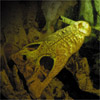 |
|
| Crocodile Cave • Abaco Bahama |
Text by Brian Kakuk
Photography by Curt Bowen |
| The cave associated with this sink is an interesting mix of solutional passages, eroded speleothems, and unique, deep mud banks that show evidence of drying and cracking during ancient low sea levels, the latter item being found as deep as 170 feet in some parts of the system. |
|
|
|
 |
|
| Deep Hole Expedition |
| Text and photography by Curt Bowen |
| To descend into the inky blackness, professional underwater cave explorers, Curt Bowen of the ADM Exploration Foundation and Jim Culter of Mote Marine, organize their specialized cave diving equipment as the other team members prep the down lines and lowered the “shark cage”, converted into a temporary alligator cage, into the water. |
|
|
|
 |
|
| Du An China - The Land of the Ancient Abyss |
| Text by Curt Bowen |
Massive cave entrances, some a hundred meters wide, dot the landscape from the upper mountain gorges to the flat plain valley along Red River. Mountain cave resurgences supply millions of gallons of water during the summer rainy season, feeding the rice paddy fields. Due to the remoteness and shear number of caves, the possibility of great discoveries is immense. |
|
|
|
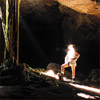 |
|
| Dzonote Maya |
| Text and photography by Curt Bowen |
As we maneuvered into the Northwest of Mexico’s Yucatan, the transition was made from that of the coastal tourist to that of a jungle denizen. The Mayans who dwelled in these remote locations, although quite poor, were rich in spirit, always eager to assist us.
|
|
|
|
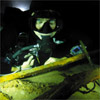 |
|
| Discovery of Sacred Waters |
Text by Rusty Farst
Photography by Curt Bowen |
| One of the most magnificently decorated cenotes ever discovered in the state of the Yucatan revealed itself for the first time to Explorer Brett Hemphill. Squeezing through a small hole he dropped through the roof of an immense crystal clear chamber filled with enormous stalactites and the Yucatan’s largest standing stalagmite measuring over 15 feet in diameter and standing over 40 feet tall. |
|
|
|
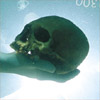 |
|
| Exploration • Discovery • Documentation • Preservation |
Text by Jill Heinerth
Photography by Wes Skiles |
| Now, in the shadows of Chicxulub rests a circle of openings leading to a labyrinth of underground rivers and caves harboring untold secrets about the history of the Earth. Deep beneath the limestone bedrock, the blemish caused by Chicxulub reaches its tendrils to the surface leaving a pockmarked ridge that we now call the Ring Cenotes. |
|
|
|
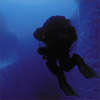 |
|
| Ice Island |
| by Jill Heinerth |
| The skies and seas are a continual parade of life and color. The environment changes by the minute as the sun tracks around the horizon. To sleep is to miss a transient moment when you might see a seal lounging on the ice or a skua swooping down on a penguin chick or an iceberg that looks like a modern art sculpture. |
|
|
|
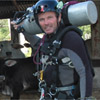 |
|
| Iglesia • Hidden Passages Expose Mayan History |
Text by Tracy Raz
Photography by Jeff Toorish and Curt Bowen |
| The Maya participated in human sacrifice and brutal games in which the loser (or, some would argue, the winner) would pay the ultimate price of death. During these religious events, the Maya offered special sacrifices into these cenotes in an effort to satisfy their gods. |
|
|
|
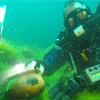 |
|
| Isla Del Sol - Bolivia - Lake Titicaca |
| Text and Photography by Erik Foreman and Keith Ambrose |
| At a height of 12,500 feet, the atmospheric pressure is nearly half of that at sea level. The isolation and altitude would be a real challenge. Very little diving has been conducted in this remote spot. In 1968 Jacques Cousteau took his crew and equipment there to explore the lake. Divers spent days searching, but found nothing man-made. Cousteau concluded the legends were a myth. |
|
|
|
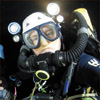 |
|
| Kija Blue - Australia's Remotest Cave Exploration |
| Text by Richard Harris |
| A massive sinkhole or cenote, many miles from the remote township of Warnum was the reason for our makeshift camp in this loneliest part of Australia. Swags and wetsuits marked the temporary home of the six explorers who came from different corners of the country with the common goals of discovery and adventure… |
|
|
|
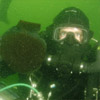 |
|
| Lago De Yojoa • Where water accumlates on the earth |
Text by Chris Borgen
Photography by Erik Foreman and Chris Borgen |
| It is easily one of the most picturesque places in all of Central America. With unsurpassed amounts of fresh water and local fishing, it’s no wonder the families in this area date back to the pre classic period. |
|
|
|
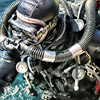 |
|
| Mystifying Leviathans of Cay Sal |
| Text by Brock Brinkerhoff |
| Darkness set in quickly, and the lights came out. Me with my trusty 10W HID and John with a prototype LED light head, provided by Titan. As we descended, the wall undulated from ledge to undercut. Descending even deeper, it was as though someone turned the “Scale” knob up – all of the features appeared rougher, less worn, and larger gaps appeared between eroded walls. The undercuts also became more severe. This resulted in a zigzag swimming pattern in order to stay in visual contact with the wall. |
|
|
|
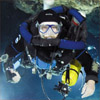 |
|
| Expedition to Lanzarote - Into the Lava Dome |
| Text and photography by Jill Heinerth |
| Just 60 miles from the North African coastline, the beautifully peaceful island of Lanzarote hides its volatile past. Along this island arc are dynamic features that have revealed the earth’s innermost geologic secrets for perhaps millions of years. Sudden, violent eruptions have formed virgin islands overnight. To modern cave divers, Lanzarote has more than just a fiery history. Over a quarter century ago, this, the longest submerged lava tube in the world, almost claimed the life of cave diving pioneer Sheck Exley |
|
|
|
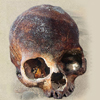 |
|
| Maya Underworld • Xibalba reveals more secrets |
Text by Walter Pickel
Photography by Curt Bowen |
| The collaboration between INAH (Mexico’s Archaeological Department) and the ADM Exploration Foundation permitted the recovery and documentation of this unique pre-Classic ceramic vessels. Our team returns to recover... |
|
|
|
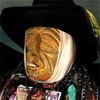 |
|
| Mayans, Myths, and Monsters |
Text by Jeff Toorish
Photography by Curt Bowen and Jeff Toorish |
| As with so many deep lakes, Atitlan is home to an alleged monster. The myth goes something like this: During mid-day when the winds whip around the volcanoes and high mountains, the water of the lake becomes angry. The fabled lake monster, a serpent, lures boats to the center of the lake where it sucks them to the depths, never to be seen again. |
|
|
|
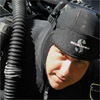 |
|
| Mystical Faces Escape from Captive Places |
Text by Jeff Toorish
Photography by Curt Bowen and Jeff Toorish |
| There have long been rumors of an underwater city beneath the waves of the lake. One theory holds that an earthquake pushed an existing Mayan city into the lake; the other notion suggests a city built close to the lake was flooded when the waters rose tens of thousands of years ago. |
|
|
|
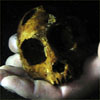 |
|
| New Cave - Old Species • Dominican Republic Cave Exploration |
Text by Lindsey Pickel
Photography by Curt Bowen |
| We “power snorkeled” the sump in teams of two in order to maximize visibility. Like the other caves, we were met with bone-white limestone and perfect visibility, but that is where the similarities ended. Once we reached the cave’s dry passage, we were amazed by the pristine dry formations that stretched as far as you could see. |
|
|
|
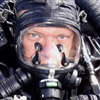 |
|
| Osprey Reef • Close to the Edge |
Text by Ross Isaacs
Photography by Lance Robb and Ross Isaacs |
| Discovered in 1803, Osprey Reef is located 120 nautical miles east of the Australian mainland, beyond the Great Barrier Reef. The reef is perched on top of an isolated seamount in the Coral Sea and is not part of the Great Barrier Reef system itself. It rises over a kilometre up from the deep-sea floor to the ocean’s surface. |
|
|
|
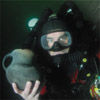 |
|
| Peten Itza • Discovery Beneath the Emerald Waters |
Text by Keith Ambrose
Photography by Curt Bowen |
| Searching the shoreline, we quickly discover specific locations where the locals still come to the water’s edge to wash, collect water, and fish. Since many of these cultures have changed very little over the last few thousand years, we figured that the paths they follow today are more than likely the same paths followed for hundreds, if not thousands, of years. |
|
|
|
 |
|
| Phantom Cave Expedition 2012 |
| Text by Walter Pickel and Tom Iliffe |
| January 2012, foundation divers completed a six day science and exploration project. Our team managaged to add over 1500 feet of cave passage to the system and also increased the maximum depth of the system from 65 feet to over 250 feet. Read more.... |
|
|
|
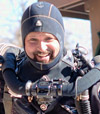 |
|
Phantom Cave Expedition 2013
MAGNUS HALL |
| Text by Curt Bowen, Jason Richards, and Andy Pitkin |
As they descended to 400 ffw in depth, they noticed more chert nodules jutting from the walls, similar to the abundant amounts seen in the shallow section between 20 and 30 ffw but strangely absent between. A prominent dark formation protruded from the silt floor, possibly either a complex piece of chert or a fossilized coral. While Andy tied off to this ideal point, Brett looked ahead...
Read More.... |
|
|
|
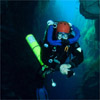 |
|
| Piccaninnie Ponds… Hidden Treasures |
| Text by Richard Harris |
| In the extensive swamplands of the Piccaninnie Ponds Conservation Park, lies a freshwater marvel unlike any other in Australia; Piccaninnie Blue Lake, affectionately called “Pics”. A truly unique feature even compared with the numerous other stunning sinkholes of the Mount Gambier karst region of South Australia. |
|
|
|
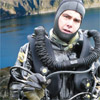 |
|
| Quilotoa • Ecuador's Volcanic Crater |
Text by ADM Explorer Erik Foreman
Photography by Luis Ya Lamuaya |
| Extreme solo diving is not for everyone; but for me, this only added to the challenge. How would I know my mix at altitude in the thin air of the Ecuadorian Andes? Mathematics. |
|
|
|
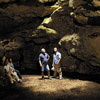 |
|
| Thats why they call it Exploration and not Discovery • Yucatan 2007 |
Text by Jeff Toorish
Photography by Curt Bowen and Jeff Toorish |
A strange sight for any passing cattle rancher, diver Matt Mandzieuk dresses in full side-mount and climbing equipment, makes his way through the Yucatan scrub jungle to be the first to explore the bottom of Cenote Cutzi.
|
|
|
|
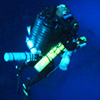 |
|
| The Pit and The Blue Abyss |
Text by Krzysztof Starnawski
Photography by Irena Stangierska |
| The Pit and Blue Abyss are one of the few places dropping deep (70m – 110m) and allowing exploring lower levels of caves. At that depth diver is diving in salt water and the salt water would lead to a significant amount of rock corrosion. With two caves in close proximity to each other (about 500 m) one can conclude that they may drop into the same deep collector. |
|
|
|
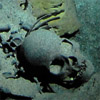 |
|
| Virgins, Violence, and Videotape |
Text by Jeff Toorish
Photography by Curt Bowen and Jeff Toorish |
| More than a dozen human remains are hidden beneath the waters of San Antonia Excucul (abbreviated to San Antonia). To enter, we must rappel through a narrow well shaft and drop about 40 feet to the water, after which it is a relatively straightforward dive. |
|
|
|
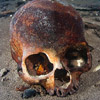 |
|
| Xibalba • Yucatan 2011 Expedition |
Text by Walter Pickel and Jon Bojar
Photography by Curt Bowen, Walter Pickel, Jon Bojar, and Jeff Toorish |
| The Mayan word “Xibalbá” roughly translates as “World of the Dead,” a dangerous underworld ruled by demons. For the Maya, caves and water sources were symbolic interfaces between the surface and the underground world. |
|
|
|
 |
|
| Yucatan 2007 ADM Cave Expedition |
Text by Jeff Toorish
Photography by Curt Bowen and Jeff Toorish |
| The cave itself twisted down revealing a central column, but very little in the way of archaeological relics. It was obvious that the cavern and pool of water were popular with local residents, but that the underwater cave itself was unexplored. |
|
|
|
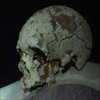 |
|
| Yucatan 2010 Expedition "Get on Rope" |
Text by Jeff Toorish
Photography by Curt Bowen, Walter Pickel, and Jeff Toorish |
| At the bottom of the debris pile was what looked like an old teapot; but, upon further examination, Bowen realized it was far from a teapot. It was unique, pristine, and a very important find. |
|
|
|
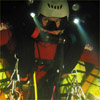 |
|
| Zrmanjin Zov - Exploration to 205m / 672ft |
Text by Luigi (Gigi) Casati
|
| On July 28th, after two endless days spent watching the other guys diving, I am finally ready for a new exploration attempt. We get to the lake later than usual, it’s almost noon. I had prepared everything the day before, so the only things I have to do are to perform a final check of the analyzers’ calibration and to put on the gear and equipment. Once in the water, I go down to -6 meters to check the sensors. |
|
|
|
|